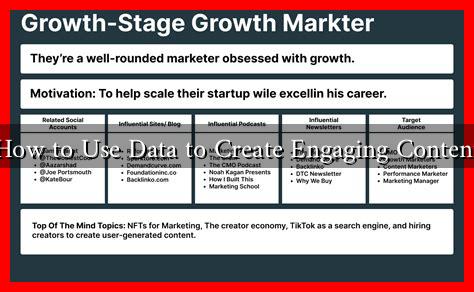-
Table of Contents
How to Use Data to Create Engaging Content
In the digital age, content is king, but not all content reigns supreme. To create engaging content that resonates with your audience, leveraging data is essential. Data-driven content not only enhances the quality of your material but also ensures that it meets the needs and preferences of your target audience. In this article, we will explore how to effectively use data to create compelling content that captivates and converts.
Understanding Your Audience Through Data
The first step in creating engaging content is understanding your audience. Data analytics can provide insights into who your audience is, what they like, and how they consume content. Here are some methods to gather audience data:
- Website Analytics: Tools like Google Analytics can help you track user behavior on your site, revealing which pages are most popular and how long visitors stay.
- Social Media Insights: Platforms like Facebook and Instagram offer analytics that show demographic information and engagement metrics for your posts.
- Surveys and Polls: Directly asking your audience about their preferences can yield valuable qualitative data.
For example, a study by HubSpot found that companies that prioritize audience data are 6 times more likely to be profitable year-over-year. By understanding your audience, you can tailor your content to meet their specific needs and interests.
Identifying Content Trends with Data
Once you have a grasp of your audience, the next step is to identify content trends. Data can help you discover what topics are currently resonating with your audience. Here are some tools and techniques to consider:
- Google Trends: This tool allows you to see the popularity of search queries over time, helping you identify trending topics in your niche.
- Keyword Research Tools: Tools like SEMrush and Ahrefs can provide insights into what keywords are driving traffic to your competitors’ sites.
- Social Listening Tools: Platforms like Hootsuite and Brandwatch can help you monitor conversations around specific topics, giving you insight into what your audience is discussing.
For instance, BuzzSumo, a content research tool, found that articles with data-driven insights receive 94% more views than those without. By tapping into current trends, you can create content that is timely and relevant.
Creating Data-Driven Content
With a clear understanding of your audience and current trends, you can start creating data-driven content. Here are some strategies to consider:
- Use Statistics and Case Studies: Incorporate relevant statistics and real-life case studies to back up your claims. This not only adds credibility but also engages readers.
- Visualize Data: Use infographics, charts, and graphs to present data in a visually appealing way. Visual content is more likely to be shared and remembered.
- Tell a Story: Use data to tell a compelling story. For example, instead of just presenting numbers, explain what they mean for your audience and how they can apply this information.
For example, a blog post that discusses the impact of remote work on productivity could include statistics from a survey conducted by Buffer, which found that 98% of remote workers want to continue working remotely at least some of the time. This not only provides valuable insights but also engages readers by addressing a topic they care about.
Measuring Engagement and Iterating
After publishing your content, it’s crucial to measure its performance. Use analytics tools to track engagement metrics such as:
- Page views
- Time on page
- Social shares
- Comments and feedback
By analyzing these metrics, you can identify what works and what doesn’t. For instance, if a particular type of content consistently receives high engagement, consider creating more of that type. Conversely, if certain topics or formats underperform, it may be time to pivot your strategy.
Conclusion
In conclusion, using data to create engaging content is not just a trend; it’s a necessity in today’s content-driven landscape. By understanding your audience, identifying trends, creating data-driven content, and measuring engagement, you can produce material that not only captivates but also converts. Remember, the key to successful content lies in its relevance and resonance with your audience. Embrace data, and watch your content strategy flourish.
For more insights on data-driven content strategies, check out HubSpot’s guide on data-driven content.

